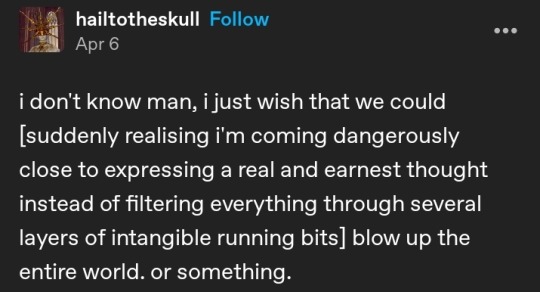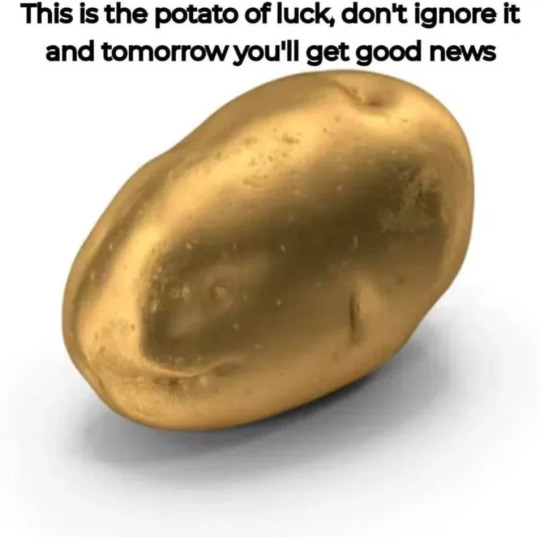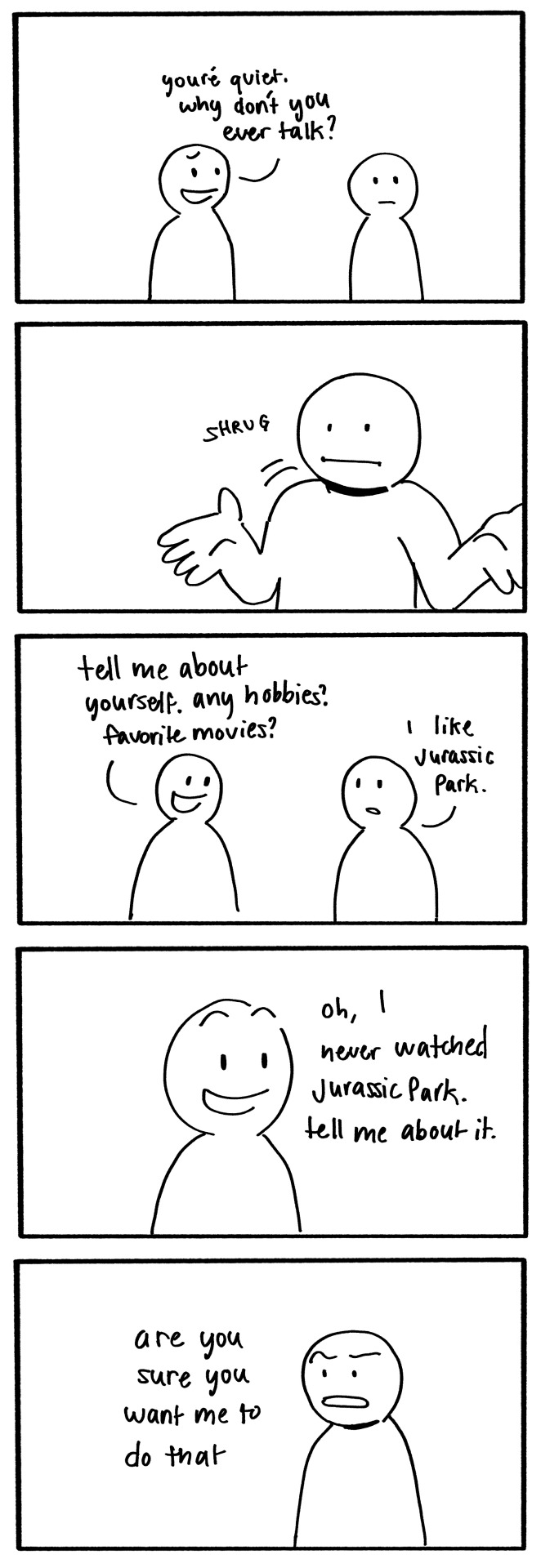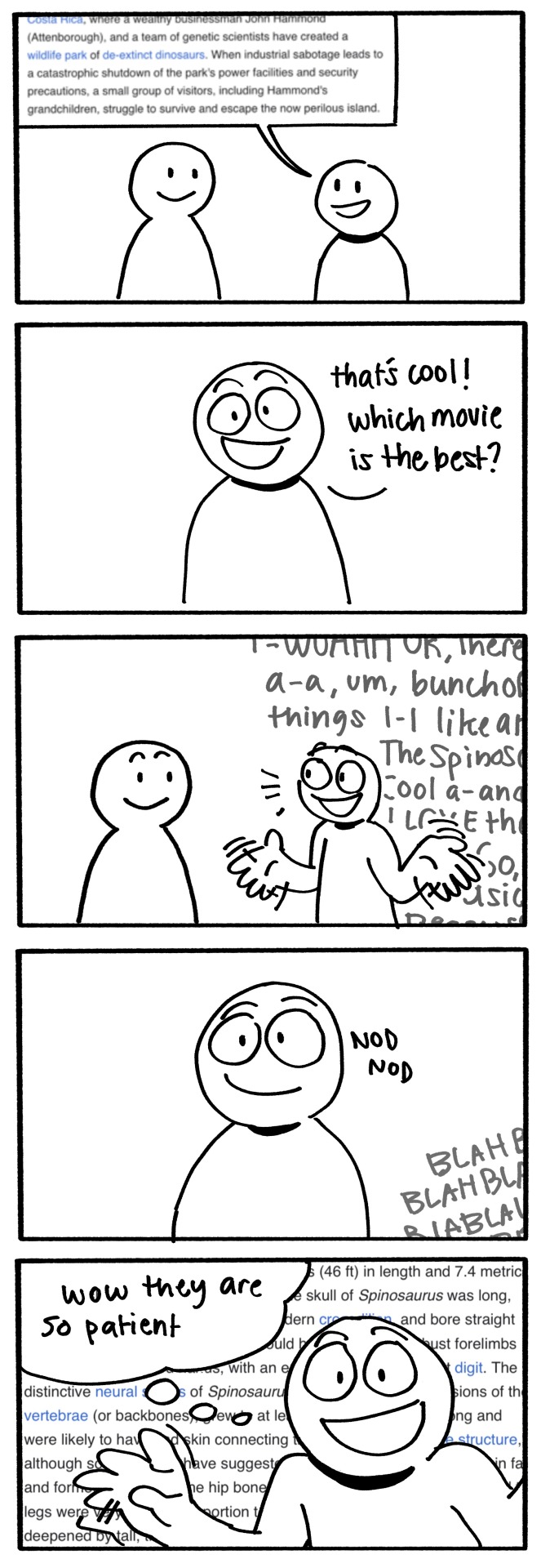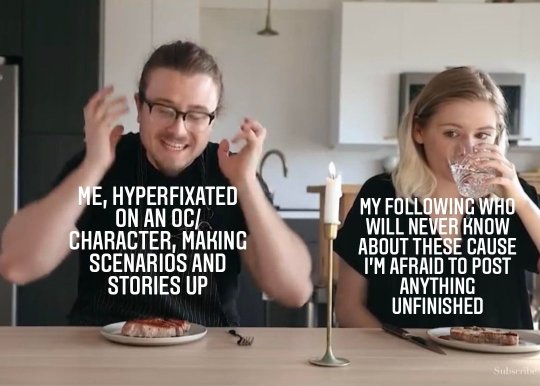Hi, I'm a French person, she/they, I'm an artist who is just having fun around and who wants to share positive vibe Ask me away, I even offer constructive criticism sometimes
Don't wanna be here? Send us removal request.
Note
Who's one of your favorite ocs that you've made and why?? :D (there's an ask function and I should probably use it lmaoo)
Ooooooh! It's tricky! As I probably have over 300 OCS ... (Stopped really counting after 200... Might even have more by now)
Hmmm... You can't ask a parent who their favorite child is! XD
But some that I grew fond memories with are my fursona (very first persona, back then I didn't even know what a furry was xD), my first DND character that is a very young druid dragonborn and a few fan ocs ! But yeah, I can't really chose among all those babies! Especially that a ton of them have never been shared anywhere else before xD
3 notes
·
View notes
Note
Saw that reblog on ask culture so I ask you- what's your favorite color?
Between blue and purple, the closest I can think of is the colour of "forget me not" flowers, it's a lovely shade!
1 note
·
View note
Text
Zoom In, Don’t Glaze Over: How to Describe Appearance Without Losing the Plot
You’ve met her before. The girl with “flowing ebony hair,” “emerald eyes,” and “lips like rose petals.” Or him, with “chiseled jawlines,” “stormy gray eyes,” and “shoulders like a Greek statue.”
We don’t know them.
We’ve just met their tropes.
Describing physical appearance is one of the trickiest — and most overdone — parts of character writing. It’s tempting to reach for shorthand: hair color, eye color, maybe a quick body scan. But if we want a reader to see someone — to feel the charge in the air when they enter a room — we need to stop writing mannequins and start writing people.
So let’s get granular. Here’s how to write physical appearance in a way that’s textured, meaningful, and deeply character-driven.
1. Hair: It’s About Story, Texture, and Care
Hair says a lot — not just about genetics, but about choices. Does your character tame it? Let it run wild? Is it dyed, greying, braided, buzzed, or piled on top of her head in a hurry?
Good hair description considers:
Texture (fine, coiled, wiry, limp, soft)
Context (windblown, sweat-damp, scorched by bleach)
Emotion (does she twist it when nervous? Is he ashamed of losing it?)
Flat: “Her long brown hair framed her face.”
Better: “Her ponytail was too tight, the kind that whispered of control issues and caffeine-fueled 4 a.m. library shifts.”
You don’t need to romanticise it. You need to make it feel real.
2. Eyes: Less Color, More Connection
We get it: her eyes are violet. Cool. But that doesn’t tell us much.
Instead of focusing solely on eye color, think about:
What the eyes do (do they dart, linger, harden?)
What others feel under them (seen, judged, safe?)
The surrounding features (dark circles, crow’s feet, smudged mascara)
Flat: “His piercing blue eyes locked on hers.”
Better: “His gaze was the kind that looked through you — like it had already weighed your worth and moved on.”
You’re not describing a passport photo. You’re describing what it feels like to be seen by them.
3. Facial Features: Use Contrast and Texture
Faces are not symmetrical ovals with random features. They’re full of tension, softness, age, emotion, and life.
Things to look for:
Asymmetry and character (a crooked nose, a scar)
Expression patterns (smiling without the eyes, habitual frowns)
Evidence of lifestyle (laugh lines, sun spots, stress acne)
Flat: “She had a delicate face.”
Better: “There was something unfinished about her face — as if her cheekbones hadn’t quite agreed on where to settle, and her mouth always seemed on the verge of disagreement.”
Let the face be a map of experience.
4. Bodies: Movement > Measurement
Forget dress sizes and six packs. Think about how bodies occupy space. How do they move? What are they hiding or showing? How do they wear their clothes — or how do the clothes wear them?
Ask:
What do others notice first? (a presence, a posture, a sound?)
How does their body express emotion? (do they go rigid, fold inwards, puff up?)
Flat: “He was tall and muscular.”
Better: “He had the kind of height that made ceilings nervous — but he moved like he was trying not to take up too much space.”
Describing someone’s body isn’t about cataloguing. It’s about showing how they exist in the world.
5. Let Emotion Tint the Lens
Who’s doing the describing? A lover? An enemy? A tired narrator? The emotional lens will shape what’s noticed and how it’s described.
In love: The chipped tooth becomes charming.
In rivalry: The smirk becomes smug.
In mourning: The face becomes blurred with memory.
Same person. Different lens. Different description.
6. Specificity is Your Superpower
Generic description = generic character. One well-chosen detail creates intimacy. Let us feel the scratch of their scarf, the clink of her earrings, the smudge of ink on their fingertips.
Examples:
“He had a habit of adjusting his collar when he lied — always clockwise, always twice.”
“Her nail polish was always chipped, but never accidentally.”
Make the reader feel like they’re the only one close enough to notice.
Describing appearance isn’t just about what your character looks like. It’s about what their appearance says — about how they move through the world, how others see them, and how they see themselves.
Zoom in on the details that matter. Skip the clichés. Let each description carry weight, story, and emotion. Because you’re not building paper dolls. You’re building people.
8K notes
·
View notes
Text
bring back tumblr ask culture let me. bother you with questions and statements
197K notes
·
View notes
Text


I'm finally playing a Toonkind character in an otherwise completely standard D&D campaign and absolutely living
348 notes
·
View notes
Text
























What the flock?! such smart names!
Science should let more cartoonists name things. That how we got the thagomizer and the Rube Goldberg machines. Anyways! SHERLOCK CROWMES!!!!!
Check out my stuff!
✧Read Namesake✧ ✧Read Crow Time✧ ✧Store✧ ✧Patreon✧
25K notes
·
View notes
Text
rb this to give the person you reblogged from a very tiny frog
109K notes
·
View notes
Text
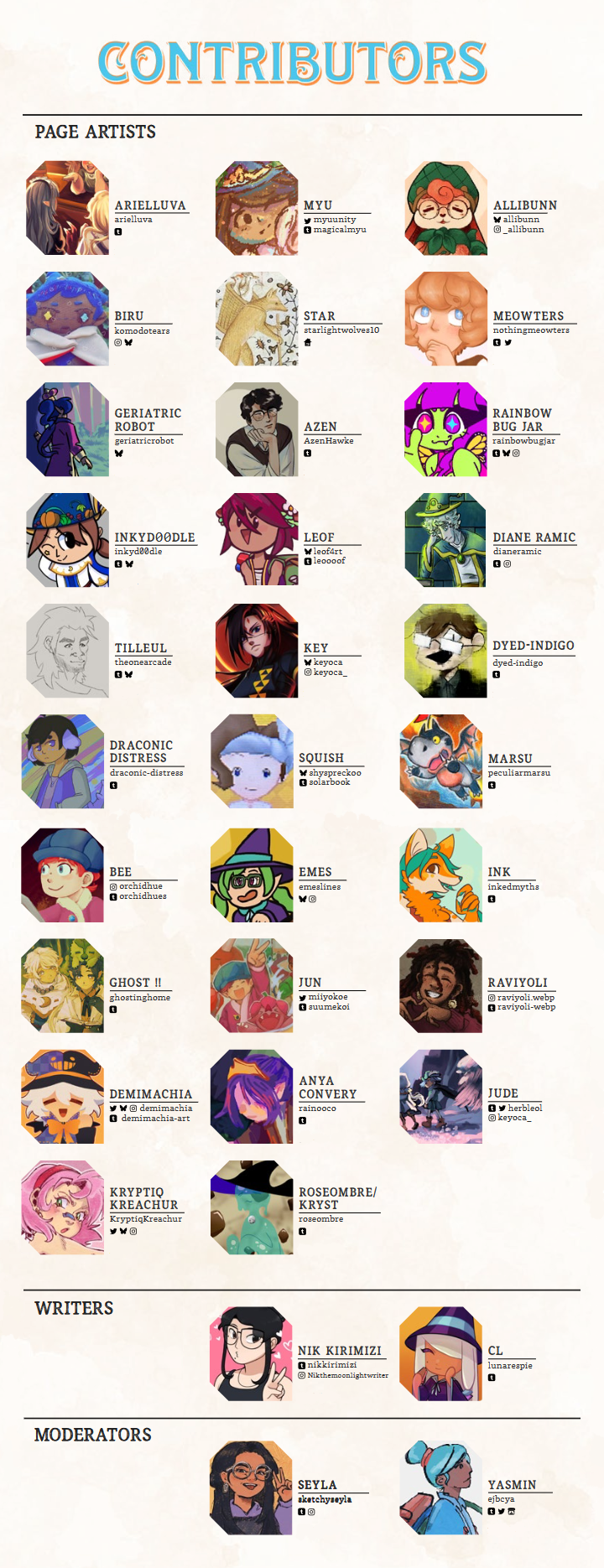
Thank you to all our contributors for "Our Fantasy Lives"!
We are excited to finally share what we have been working on soon! The zine will be available on our itch.io page and the full plain text credit list alongside linked socials is accessible below.
arielluva (tumblr)
Myu (twitter, tumblr)
allibunn (bluesky, instagram)
Biru (instagram, bluesky)
Star (toyhou.se)
Meowters (twitter, tumblr, side tumblr)
geriatricrobot (bluesky)
Azen (tumblr)
rainbow bug jar (bluesky, tumblr, instagram, personal site)
Inky Doodle (tumblr, bluesky)
Leof (tumblr, bluesky)
Diane Ramic (tumblr, instagram)
Tilleul (tumblr, bluesky)
Key (bluesky, instagram)
dyed-indigo (tumblr)
DraconicDistress (tumblr)
Squish (bluesky, tumblr)
Marsu (tumblr)
Bee (tumblr, instagram)
Emes (instagram, twitter)
Ink (tumblr)
Ghost !! (tumblr)
Jun (twitter, tumblr)
Raviyoli (instagram, tumblr)
Demimachia (twitter, bluesky, instagram, tumblr)
Anya Convery (instagram)
Jude (twitter, tumblr, instagram)
Kryptiq Kreachur (twitter, instagram, bluesky)
RoseOmbre/Kryst (tumblr)
Nik Kirimizi (tumblr, instagram, facebook)
CL (tumblr)
Seyla (tumblr, instagram)
Yasmin (tumblr, twitter, itch.io)
51 notes
·
View notes
Text
i mean this in the gentlest way possible: you need to eat vegetables. you need to become comfortable with doing so. i do not care if you are a picky eater because of autism (hi, i used to be this person!), you need to find at least some vegetables you can eat. find a different way to prepare them. chances are you would like a vegetable you hate if you prepared it in a stew or roasted it with seasoning or included it as an ingredient in a recipe. just. please start eating better. potatoes and corn are not sufficient vegetables for a healthy diet.
156K notes
·
View notes


